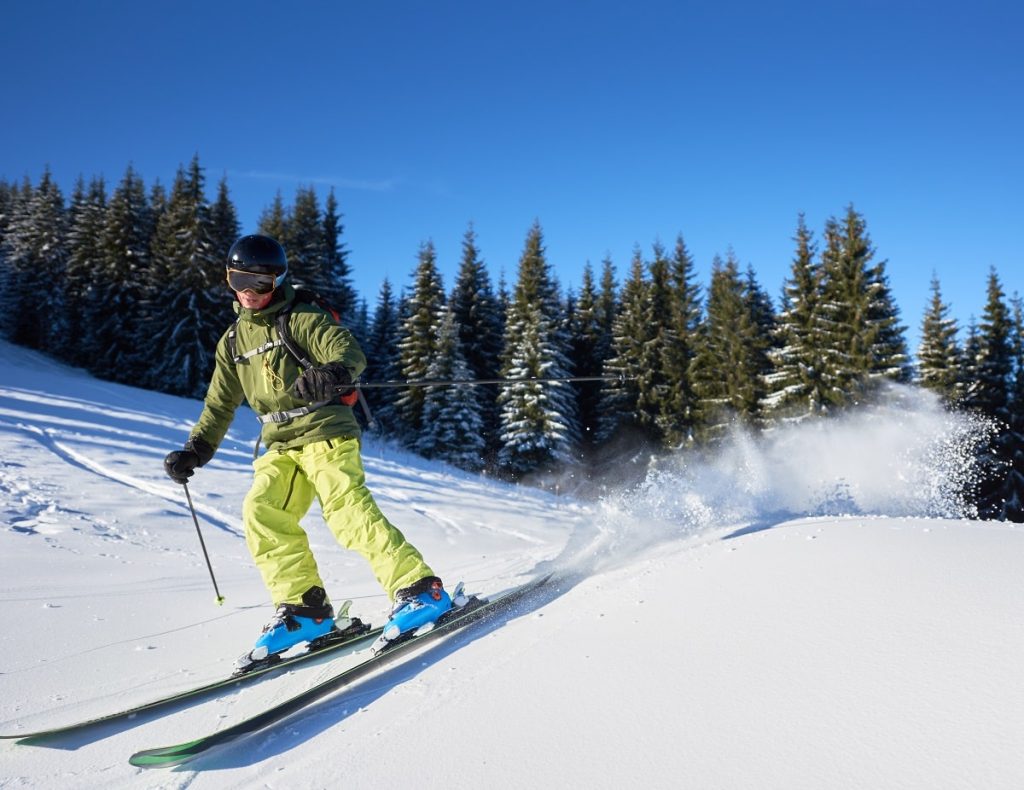
Ski jumping is a sport that requires a combination of bravery and precision. This combination allows ski jumpers to glide gracefully off the slopes and land safely. A skier can achieve speeds of up 100 kilometers an hour during a successful jump. This sport can also be dangerous if done incorrectly.
One of the most important rules of ski jumping is that a jumper cannot exceed 4.5 meters off the ground during the course of their jump. American skier Werner Lesser jumped 41m (135 ft) in 1954.
A ski jumper can earn 60 points if they land on the K-point. This is the most flat portion of a landing area. Judges will remove points from jumpers who are too close to the landing area. A jumper who crosses the Kpoint of a large hill will receive 1.8 point.

As well as the most obvious measure of success, a skier can earn style points by demonstrating a fancy-pants jump. This could include pointing the skis' tips outward, leaning forward or moving one's arms.
However, it is not unusual for a jumper to crash, and the real challenge is maintaining control and a smooth descent. A few skiers have been even injured while jumping. In a perfect universe, a skier would be able landing on a sloped area without hitting ground.
The knoll is the first part of a landing area. It connects P, the point of entry into the landing zone, to K, the flattest section. In order to maximize the points scored, the skier might make a second leap.
There are many tricks to the trade, aside from the obvious rule of thumb. One trick is to lean forward so that the ski can be lifted. It is important to remember that jumpers must be confident and brave enough to jump forward.

The best way to test out these tips is to get a practice run. This is especially important if the first timer. This will allow you to learn the basics and improve your technique. You can also participate online in world cup tournaments, or weekly tournaments. If you want to join an online group, check out a website like SkiJumping.com. These websites enable you to meet fellow ski jumping enthusiasts around the globe.
Ski jumping is a sport that offers thrills and excitement, even though the rules are very strict. Skiers with skill and strength can accomplish amazing feats. There are no identical jumps.
FAQ
How do you prepare your body for vacation?
To live a healthy life on vacation, you need to eat well and exercise.
Be sure to stay hydrated and well rested before you leave home.
All necessary travel documents should be prepared.
You should also ensure that you have enough medicine to last you through your trip if you plan to take any medication.
Make sure you bring a change of clothes in the event that you are injured or get sick.
Should I buy travel insurance?
If you plan to do something adventurous, travel insurance is crucial. It's important that you are covered for all kinds of adventure sports.
If you're skiing, for example, it is important to have medical coverage. You should also look into getting coverage for things like theft, loss, and damage.
You should also consider buying cover for cancellation. This means that you can cancel your holiday without paying any penalties.
You should also ask for coverage for emergency evacuation. You can also be taken off the mountain in the event of an avalanche, or another natural disaster.
How can I travel light and how do I get there?
There are many options when it comes to packing for a trip. Here are some tips to help you decide what to pack.
-
Bring only what you really need.
-
Only pack what you will actually wear.
-
Don't buy too many.
-
Take enough room in your suitcase
-
Double-check everything that you have packed.
-
Enjoy free storage
-
Reusable water bottles can be used instead of buying bottled.
-
Use a backpack to carry your stuff instead of a bag.
-
Walk or cycle whenever possible instead of using public transport.
-
Pick the right size bag
-
Avoid carrying heavy items.
-
Be prepared for all eventualities
-
Leave nothing behind.
Where should I store my luggage?
There are many options. One of the most popular options is to use airport lockers. These are typically located near the security zone. These lockers cost $5-10 per day depending on their size.
Renting a storage unit is another option. These units are commonly found outside shopping centers or large hotels. While prices can vary, there are some places that offer discounts for multiple units being rented together.
A third option is to hire a porter. A porter will help carry your luggage from the carousel to your room. For each porter you hire, you pay a small amount.
Statistics
- Alcoholic beverages with more than 24% but not more than 70% alcohol are limited in checked bags to 5 liters (1.3 gallons) per passenger and must be in unopened retail packaging. (tsa.gov)
- That's an 18% jump from 2019, the previous record year. (travelandleisure.com)
- They're also likely to offer babysitting services, in case you'd like to have dinner one night after 7 p.m. (travelandleisure.com)
- You can use compression sacs or cubes to reduce the volume of your clothes by up to 80%—this is especially convenient for bulky items such as sweaters and jackets. (eaglecreek.com)
- Case in point: the private island of Ilha Caldeira, less than seven miles off the coast as part of the Primeiras and Segundas Archipelago, is located within the marine-protected area with 20 percent of the country's intact living coral. (travelandleisure.com)
External Links
How To
How to plan for your next holiday
Planning a trip requires many things, such as booking flights and hotels, car rentals, activities, and so on. It includes important considerations such a budget, destination, weather forecast, time frame, etc.
These points are essential to keep in mind when you plan your next vacation.
We've created a step by step guide to help you plan your next holiday. This guide has been prepared based on our experience and customer feedback. We hope that by following this guide, you can plan your next vacation without any hassle.
Steps:
-
Plan your Budget - This is the most important step to take when planning for a trip. Before you start to think about where to go or what to do, it is important to determine how much money you have available for your trip. If you don’t have enough money, it might be necessary to cancel your trip.
-
Book Your Tickets - Once you've decided on your budget and set your priorities, booking your flight tickets is the first thing that you should do. Be sure to get the lowest price flight deal. You should also check to see if any airlines offer special deals during specific seasons. These deals can save you lots of money.
-
Pick Your Destination. Once you've booked your tickets, the next step is to decide where to travel. Multiple factors play into the decision of where to go, climate (when you can visit), culture (how friendly they are) and cost (how expensive it is).
-
Find Accommodations. There are many options for accommodation, from budget hostels to luxurious suites. Your needs and preferences will determine the type of accommodation that you choose. A hotel is not the best choice if you want to be close to the city centre. However, homestays may be more suitable for you if your preference is quieter and away from crowds.
-
Select Activities and Attractions. Now, after you've selected your accommodation it is time to pick the activities or attractions that you would like to add to your itinerary. Depending on your length of stay, you may choose to add or remove activities.
-
You can now determine your schedule. To achieve maximum value from your trip, you should stick to a fixed schedule. However, if you're free to move around at your convenience, you can enjoy your trip even more.
-
Create Itinerary - Creating an itinerary includes all the information about your trip. These information can include flights, accommodations, activities and restaurants. You will need to record them all and make a list.
-
Research Online – Make sure you research everything before you leave on your trip. Find out what other travelers have to say about different destinations by reading reviews and testimonials. This will allow you to plan your trip accordingly.
-
Pack Lightly - One of the biggest mistakes people make when packing is bringing too many clothes. Avoid bringing more than three sets of clothes. Make sure you bring clothes that are appropriate for the area.
-
Make sure you are prepared - Before you leave for your trip, make sure that everything is in order. Do not waste your time looking for important documents when you are in transit.